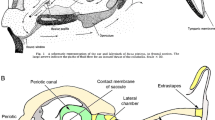Summary
The papilla basilaris of scincid lizards is relatively long, slightly curved or bowed, and characteristically has an apical terminal expansion. A limbus-attached tectorial membrane is present but is apparently not continuous with the tectorial material covering the hair cells of the papilla. The hair cells of the apical expansion are covered by a thick spongy mass of tectorial material, while the hair cells above (dorsal to) the apical region are covered by thickened tectorial material that is in the form of uniquely sculptured, twisted or folded drape-like masses (sallets). The surface of the basal (dorsal) quarter of the papilla is unusual in that it is concave rather than convex. The expanded terminals of the hair cell kinocilia are also unusual in being arrowhead-shaped.
Kinocilial orientation of the non-apical papillary hair cells is simply bidirectional; the hair cells on each side of the papillary axial midline are oriented toward the midline. Kinocilial orientation of the hair cells of the apical expansion is more complex with the peripheral neural and abneural rows both being abneurally directed, and the central rows being at first neural in orientation, but becoming abneurally oriented as the apical tip is approached. At the apical tip region, most all hair cells are abneurally oriented.
Similar content being viewed by others
References
Anderson, T.: Techniques for the preservation of three-dimensional structure in preparing specimens for the electron microscope. Trans. N. Y. Acad. Sci., Ser. II 13, 130–134 (1951)
Bagger-Sjöbäck, D., Wersäll, J.: The sensory hairs and tectorial membrane of the basilar papilla in the lizard, Calotes versicolor. J. Neurocytol. 2, 329–350 (1973)
Baird, I. L.: A survey of the periotic labyrinth in some representative recent reptiles. Kans. Univ. Sci. Bull. 41, 891–981 (1960)
Baird, I. L.: Some histological and cytological features of the basilar papilla in the lizard, Anolis carolinensis. Anat. Rec. 157, 208–209 (1967)
Baird, I. L.: Some findings of comparative fine structural studies of the basilar papilla in certain reptiles. Anat. Rec. 163, 149 (1969)
Baird, I. L.: The anatomy of the reptilian ear. In: Gans, C. and Parsons, T. (eds.), Biology of the reptilia, vol. 2, p. 193–275. New York: Academic Press 1970
Baird, I. L.: Anatomical features of the inner ear in submammalian vertebrates. In: Keidel,W. D. and Neff, W. D. (eds.), Handbook of sensory physiology. Auditory system, vol. V. Berlin-Heidelberg-New York: Springer (in press, 1974)
Hamilton, D. W.: Observations on the morphology of the inner ear in certain gekkonoid lizards. Univ. Kans. Sci. Bull. 41, 983–1024 (1960)
Hamilton, D. W.: The inner ear of lizards. I. Gross structure. J. Morph. 115, 255–271 (1964)
Miller, M. R. The cochlear duct of lizards. Proc. Calif. Acad. Sci. 33, 255–359 (1966a)
Miller, M. R. The cochlear duct of lizards and snakes. Amer. Zool. 6, 421–429 (1966b)
Miller, M. R. The cochlear duct of snakes. Proc. Calif. Acad. Sci. 35, 425–475 (1968)
Miller, M. R. A scanning electron microscope study of the papilla basilaris of Gekko gecko. Z. Zellforsch. 136, 307–328 (1973a)
Miller, M. R. Scanning electron microscope studies of some lizard basilar papillae. Amer. J. Anat. 138, 301–330 (1973b)
Miller, M. R. Scanning electron microscopy of the lizard papilla basilaris. Brain Behav. Evol. (in press, 1974)
Mulroy, M. J.: Ultrastructure of the basilar papilla of reptiles. Doctoral Dissertation, University of California, San Francisco, California (1968a)
Mulroy, M. J.: Orientation of hair cells in the reptilian auditory papilla. Anat. Rec. 160, 397 (1968b)
Weiss, T. F., Mulroy, M. J., Altmann, D. W.: Intracellular responses to acoustic clicks in the inner ear of the alligator lizard. (In press, 1974)
Wever, E. G.: Structure and function of the lizard ear. J. Auditory Res. 5, 331–371 (1965)
Wever, E. G.: The tectorial membrane of the lizard ear: types of structure. J. Morph. 122, 307–320 (1967a)
Wever, E. G.: The tectorial membrane of the lizard ear: species variations. J. Morph. 123, 355–372 (1967b)
Wever, E. G.: The lizard ear: Scincidae, J. Morph. 132, 277–292 (1970)
Wever, E. G.: The mechanics of hair-cell stimulation. Ann. Otol. (St. Louis) 80, 786–804 (1971)
Author information
Authors and Affiliations
Additional information
I would like to thank Ms Maria Maglio for her skill in handling the technical aspects of the electron microscope, Mr. David Akers for expert photographic assistance, and Ms. Michiko Kasahara for aid in all aspects of the work. Research sponsored by United States Public Health Service Grant NS-09231.
Rights and permissions
About this article
Cite this article
Miller, M.R. Scanning electron microscope studies of some skink papillae basilares. Cell Tissue Res. 150, 125–141 (1974). https://doi.org/10.1007/BF00220386
Received:
Issue Date:
DOI: https://doi.org/10.1007/BF00220386




